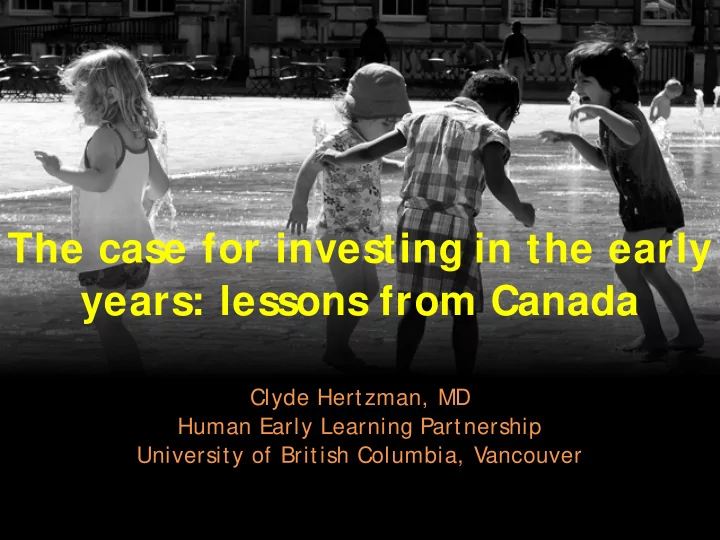

The case for investing in the early years: lessons from Canada Clyde Hertzman, MD Human Early Learning Partnership University of British Columbia, Vancouver
Sensitive Periods in Early Brain Development Pre-school years School years High Numbers Peer social skills Language Symbol Habitual ways of responding Emotional control Vision Hearing Low 1 2 3 4 5 6 7 0 Years Graph developed by Council for Early Child Development (ref: Nash, 1997; Early Y ears S t udy , 1999; S honkoff, 2000.)
What drives ECD? The experiences children have in the environments where they grow up, live and learn .
Biological Embedding Biological embedding occurs when • experience gets under the skin and alters human biodevelopment; • systematic differences in experience in different social environments lead to different biodevelopmental states; • the differences are stable and long-term; they influence health, well-being, learning, and/or behaviour over the life course.
Archeology of Biological Embedding Experience/Behavior Neural Circuitry Cell/Synapse Gene Function
Life Course Problems Related to Early Life 2 nd 3 rd / 4 th 5 th / 6 th Decade Decade Decade Old Age • S • Obesit y • Coronary Heart • Premat ure chool Failure Disease Aging • Teen Pregnancy • Elevat ed Blood • Diabet es • Memory Loss Pressure • Criminalit y • Depression
Monitoring the state of development at the level of the population and how it changes over time
The Early Development Instrument
A Population Based Measure
What Does the EDI Measure?
Neighbourhood
Neighbourhood Wave 4 Range from 3 % to 61 % Neighbourhoods
What the maps reveal… • Large local area differences in the proportion of developmentally vulnerable children • The high proportion of avoidable vulnerability •The degree to which socioeconomic context explains and does not explain variations in early development •Which communities are doing better or worse than predicted…….to set up the study of ‘why’ • Trace change over time • Rationale for programs and policies
On average, disadvantaged children have poorer outcomes, However, most vulnerable children are in the middle class Socioeconomic Socioeconomic Disadvantage Advantage
Targeting programs towards low S ES leave many vulnerable children without access HELP S ES Index High Low
Lessons learned after a decade of engagement
Lessons Learned S trong local inter-sectoral leadership
Lessons Learned Focus on EDI outcomes
Lessons Learned A focus on barriers that prevent equitable access to high quality programming
Lessons Learned Vertical coordination – local, state, commonwealth
Lessons Learned Alignment with school system
Population-based Developmental Trajectories
BC: Unique Population Laboratory Kindergarten Grade 4 Grade 7 Grade 12
Linkage of EDI to S uccess in Grade 4 90.0 Percent not meeting expectations 80.0 70.0 Reading 60.0 Numeracy 50.0 40.0 30.0 20.0 10.0 0.0 Zero One Two Three Four Five Number of EDI vulnerabilities
Observe Transitions from EDI to School Completion University Vulnerability Eligible Grades (EDI) 29% 41.5% 34% 15% 50.3% increase 10% 55.6% S ource: Adapt ed f rom Kershaw et al. 2009, 15 by 15 : A Comprehensive Policy Framework f or Early Human Capit al Invest ment in BC, Table 1..
The Benefit: GDP growth of 1% for every 1% reduction in EDI vulnerability
“Equity from the Start” Commit to and implement a comprehensive approach to early life building on existing child survival programs and extending interventions in early life to include social/ emotional & language/ cognitive development.
Thank You www.earlylearning.ubc.ca
Recommend
More recommend